ELT Pros Linkedin | Videos | Blog | Printables | ELT News | TpTs | Youtube
Chat GPT-3 by OpenAI has been stirring the pot and poking the teaching beehive. It’s an interactive (kinda social) chatbot that allows you to prompt it with questions and tasks. It’ll generate what you ask, using its deep and quick retrieval properties. Try it out - make your own assessment.
I made the above video by asking it to write a poem in the style of Charles Bukowski. I then put the poem into Steve.ai and boom, produced the video in about 10 minutes total. AI is providing efficiencies but is the content and result satisfactory, what we want? Depends.
I’m happy about the “buzz” - it is about time that teachers take account and pay attention to the potential of LI - language intelligence and NLP - natural language processing. It’s been making big leaps and bounds of progress and with the large data parameters used by GPT -3 (over 175 million - 10x more than what Microsoft uses with Turing NLG) - it can do some amazing things that offer many possibilities for educators to use it in material creation, student self-study and even regular instruction. See my online magazine with many background articles on this topic and this list of helpers and resources for using ChatGPT.
I’ll outline some of the affordances of Chat GPT-3 (ways it can be used by teachers - applications and limitations) but first a bit of an introduction and commentary on technology and education in general. [check out some of Chat GPT use/prompt examples and also what Chat GPT suggests for language educators].
Technological Paradigms
Technology comes with a set of assumptions. Paradigms, a way of looking at the world. ChatGPT-3, the ability of computers to produce coherent, human-like language is no different.
There is the fear itself that this technology will replace teachers, coders, and artists. Even content writers. This is valid but ignores the fact that at the end of the day it is US who decides how to use the technology. Technology does not impose itself on us. Or at least it shouldn’t.
The other part to this “use” story is that as technology begins to replace the “grunt” part of human activity, there is even more demand for the “art” part, the human part of the productivity cycle. Disruptive technology will mean some loss but also gain - think of handcrafts. Yes, machines now can produce t-shirts, chains, and souvenirs in quantity - yet it has also made for demand and a surge in human high-end handcrafts. It creates monetary value. For example, see how Etsy is booming in this regard. Same with many activities where technology is being disruptive - transportation, music, education, energy.
However, I do see too many using technology for technology’s sake. My wife won’t drive anywhere without her GPS loaded. She’s actually incapable of driving without said commands. And this is sad. If a human can do a similar task and even do it better - technology should not be the default. Who’s zooming who?
But what happens in the real world is we have an expectation to use technology to achieve an end or else appear “behind”. And there is also the greatest driver of technological triumphalism which Audrey Watters writes about eloquently - cost savings. Administrators, CEOs, companies using technology for purely economic profiteering, and efficiencies. In education, that is a valid fear - that technology is used for cost savings by course designers, publishers, training companies, and universities. Look! We’ll generate all your worksheets for you!
“Education technology is, despite many of our hopes for something else, for something truly transformational, often a tool designed to meet administrative goals.”
- Audrey Watters, The Algorithmic Future Of Education.
I also think too often with technology, we fall into the trap of thinking technology is “all-powerful”. With ChatGPT - many think the machine is “thinking” when in fact, it is just drawing from a large number of tokens, strings of data. A VERY large amount and making predictions. The retrieval technology is powerful. But the model is not thinking metaphorically.
Lastly, there are valid concerns with this technology - that with the data used to train it and those who did train it, Chat GPT will produce results that fortify and strengthen existing discrimination in society.
There is also the “garbage in, garbage out” factor. Teachers will need to be trained in prompting ChatGPT or else, garbage will come out. I also think we should acknowledge that while the language ChatGPT produces is “human-like”, it is generic, without voice, and even banal. Not “rich” models of human language. See this comparison of a Shakespearean sonnet produced by ChatGPT and an original. Even the rhyme scheme isn’t correct.
I think we need to think hard and fast about how and why we teachers should use ChatGPT in our lessons. There are valid reasons that teachers should produce materials with their own brains and brawn. I also don’t see ChatGPT as a deal breaker. I’ve been down this road. I produced a number of AIML chatbots in my day, trained them, and there was little uptake, use, and interest by teachers. Just early adopters, keeners. I think, for now, it’ll be the same with teachers. We aren’t there yet.
Technological Affordances
Applications and constraints of ChatGPT
Applications:
Students can use to produce work and then modify, submit it. UGC - user-generated content.
Social. Responds to the user. Allows ongoing modification of tasks.
Written output. Reading skills for students.
Language retrieval. Concordances. Language functions. Levels. Graded language. Size of responses. Vocabulary examples. Styles, Genres.
Remembers interactions with the user. Low-level personalization.
Customize content with names, places, and situations familiar to students.
Quick retrieval. Smooth functioning. Adjust the speed language is displayed.
Constraints & Limitations
No audio or visual contextualization
Models not trained specifically for education or second language learning
Generic, standard, and conventional language is retrieved.
No ability to monitor student use, share, social aspect (but possible …)
Inaccuracies. Implicit Biases. Not totally accurate in factual responses.
Cheating. Students can use it in lieu of doing their own writing and thinking. There is a possibility of OpenAI adding an identifying watermark, but not in the near future.
Concerns of privacy. Future costs - will become paid, unaffordable to most.
Lack of apps using the API in education. (but to date over 300 are currently using it). There is a big opportunity business-wise here for ELTers. What value added businesses can you create using the OpenAI api? I have a few ideas and will share in the coming weeks.
That said, there are many specific ways teachers could use Chat GPT-3 as a tool. Let me suggest just some off the top of my head.
Language examples. Students need examples - it’s a basis of learning, comparing like to like. Models help us see how language is used in different contexts and helps transfer. You can generate comparisons (informal/formal language). You can generate sentence starters or language functions in use.
Story writing - then reading. Write stories with specific vocabulary, at a certain CEFR level. Even ask that student names be used in the story.
Interactive chat. Basic Dialogues. Students can use the chat to use language purposefully and “talk” with the interface. Or a teacher can produce a dialogue for a specific situation ie. Asking for directions.
Translation. Chat GPT-3 does a great job in this.
Essay writing. Teachers are concerned with students’ cheating and using Chat GPT to game the teacher. A concern of course. There is an output detector (older) that you can use to check if student writing was generated by Chat GPT. But I’d also question, why we still are asking students to produce long-form writing? Is this really a basic skill anymore?
Error correction of a text. Add in the text, correct it and even give the student feedback.
What ways do you foresee using Chat GPT with your own students? What problems do you envision when using this technology?
I’ll be writing more in the coming weeks about this technology - that’s for sure. Please see my full set of bookmarks on this topic HERE.
I’ll end with this so valid, necessary caution.






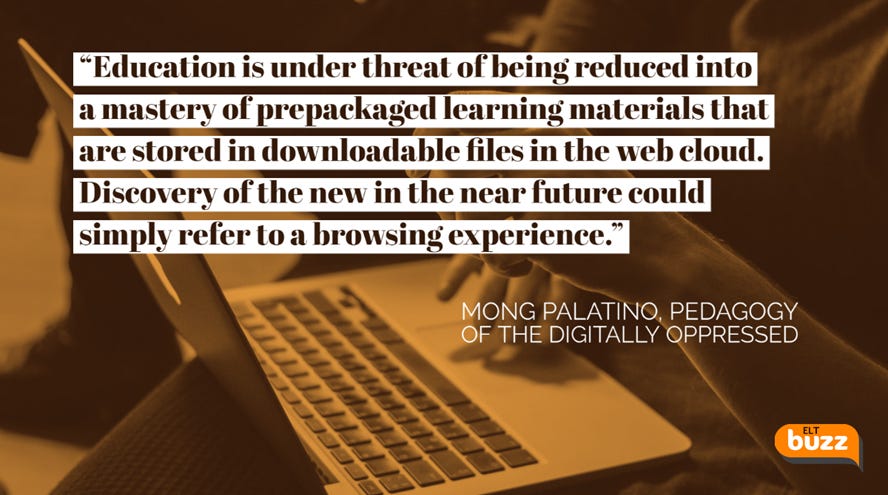

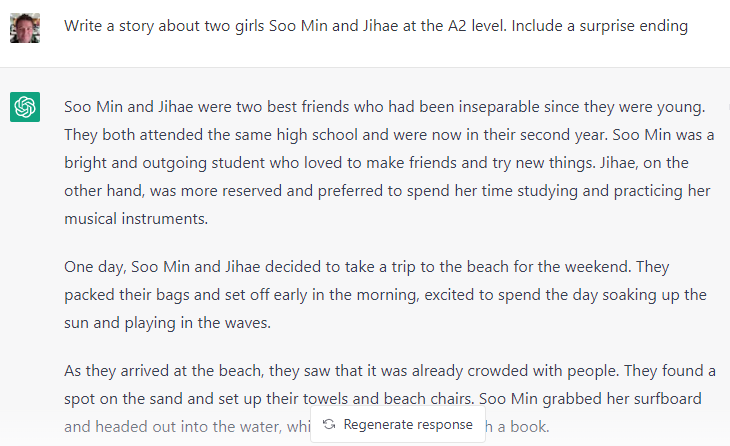
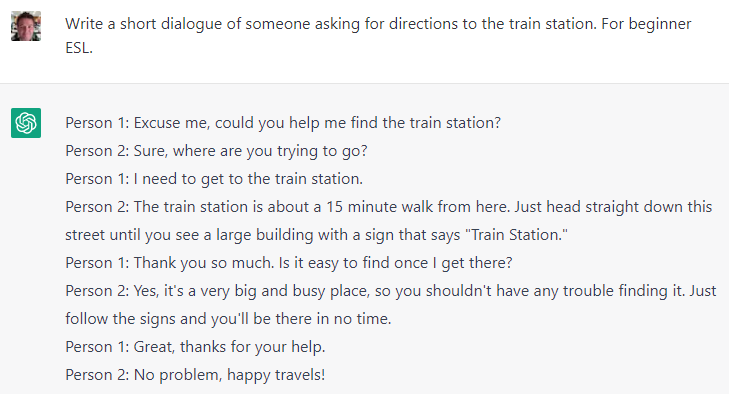
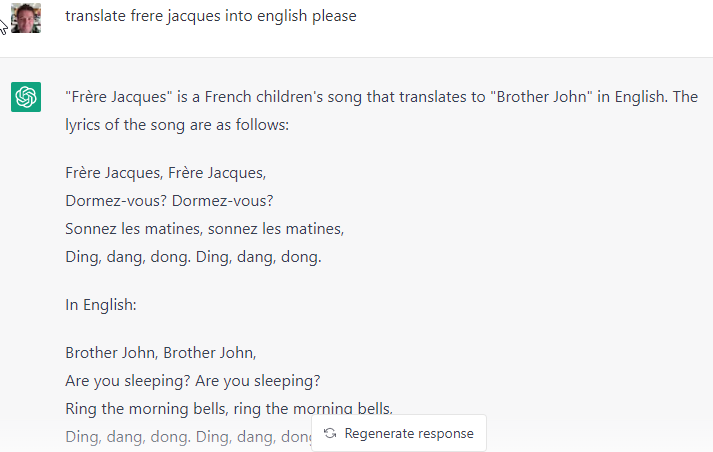
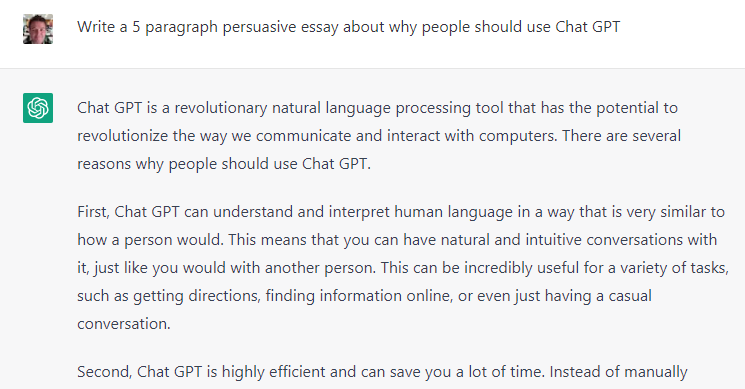

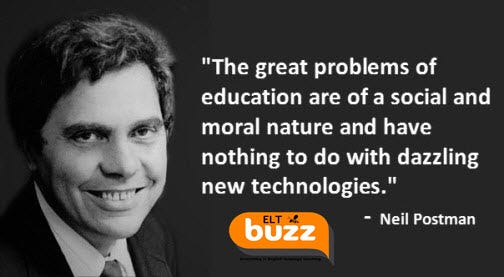

Share this post